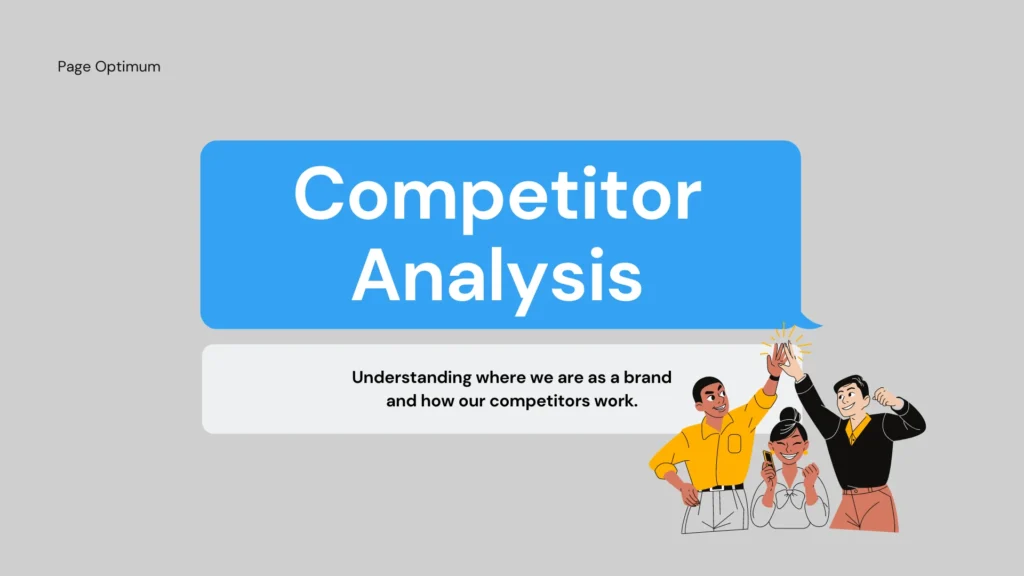Estimated reading time: 4 minutes
A detailed guide to competitor analysis, outlining methods to evaluate competitors and gain insights for strategic business growth.
Competitor analysis is a critical component of a successful business strategy.
You can gain valuable insights into the market and customer trends by analyzing your competitors’ strengths, weaknesses, and opportunities.
This comprehensive guide will provide you with the information you need to know about competitor analysis. You can now approach competitor analysis confidently, knowing what it is, why it is essential, and the techniques and tools available.

What is competitor Analysis?
Competitor analysis helps you understand your competitors’ market positioning, product offerings, and overall performance.
It will help you improve your business strategy. You can then improve your business plan.
The critical components of competitor analysis
When analyzing competitors, focus on these critical components:
- Market Share: Know how much share of the market your competitors hold.
- Product Offerings Analyzing the products or services they offer.
- Marketing Strategy Evaluation of their advertising, content SEO and Social Media efforts.
- Customer Feedback Analyzing testimonials and reviews.
- Pricing Strategy: Compare your pricing strategy to theirs.
Why is competitor analysis critical?
Strengths & weaknesses
Businesses can analyze their competitors to identify strengths and weaknesses.
You can refine your strategies to offer superior value in areas your competitors lack.
Spotting Market Opportunities
Competitor analysis helps discover untapped market opportunities.
By identifying unmet customer needs, you can attract new customers.
Enhancing Decision-Making
A clear understanding of the competitive landscape can help you to make better decisions about marketing, product development, and pricing.
You’ll also be more agile in responding to market changes.
What is the best way to conduct a competitor’s analysis?
Step 1: Identify Your Competitors
Start by identifying your top competitors. These could be directly or indirectly competing companies that offer similar or alternative products or services.
Step 2: Gather Competitive Intelligence
Collect relevant information on your competitors after identifying them. What includes:
- Analyze their website content and SEO, among other factors.
- Monitoring the social media presence of your clients.
- Reading customer reviews.
- Feature and price checking.
Step 3: Analyze Data
The data that you collected can be used to start analyzing your competitors. Compare your strengths with their weaknesses. Find patterns in customer feedback and pinpoint areas where your business can improve.
Step 4: Implement Changes
Use the analysis of your competitors to make informed decisions.
Analyzing your competitors can give you a competitive edge. You could gain a competitive advantage by researching your competitors. If you discover that your competitor offers a significantly lower price, you may consider a price-matching guarantee to gain more customers.
Best Competitor Analysis Tools
- SEMRUSH
SEMrush is a popular tool for competitor analysis. It provides insight into your competitors’ keyword strategies, traffic sources and backlinks.
- Ahrefs
Ahrefs is a powerful SEO tool that allows you to analyze the backlinks of your competitors and their keyword rankings. It helps you create the best content.
This tool gives detailed information about how competitors’ websites drive traffic.
- SimilarWeb
SimilarWeb provides website traffic and engagement metrics to compare your site’s performance.
This tool will also provide market intelligence to help you identify growth areas.
- SpyFu
SpyFu is a company that specializes in uncovering competitors’ paid and organic search strategies.
You can determine which keywords drive organic traffic to the website by analyzing the keywords they use in Google Ads.
- By avoiding these common mistakes, you can ensure that your competitor analysis is comprehensive and practical. This sense of control can be a powerful tool in shaping your business strategy. Concentrating on Direct Competitors
While analyzing direct competitors is crucial, remember indirect competitors.
Your competitors may offer alternatives to your products or services.
- Ignoring Market Trends
Market Trends have a significant impact on the performance of your competitors.
Include industry trends and changes when analyzing your competitors.
- Neglecting Customer Feedback
When it comes to analyzing competitors, customer feedback is a goldmine. Customer reviews provide valuable insights into your competitors’ performance as well as the performance of your business when it comes to meeting customer needs.
Conclusion
Competitor analysis is essential for any business that wants to stay ahead of the competition.
By identifying your competitors’ strengths and weaknesses, you can position your brand better and capitalize on growth opportunities.
This guide will provide you with tools and strategies that you can use to adapt your business and remain aware of your competition. It’s now time to put them into action. Identify your industry’s top competitors and collect all the necessary data. Keep in mind that competitor analysis is a continuous process. So, review it frequently to stay on top of things.